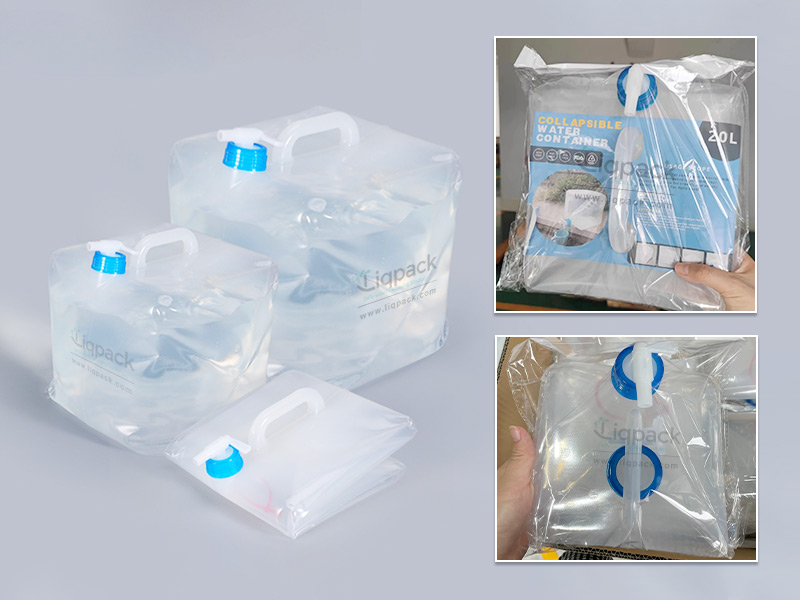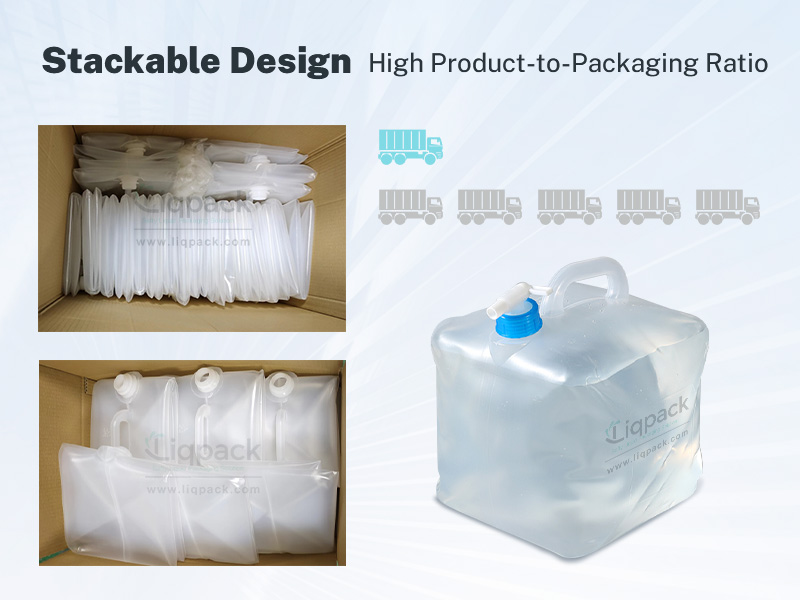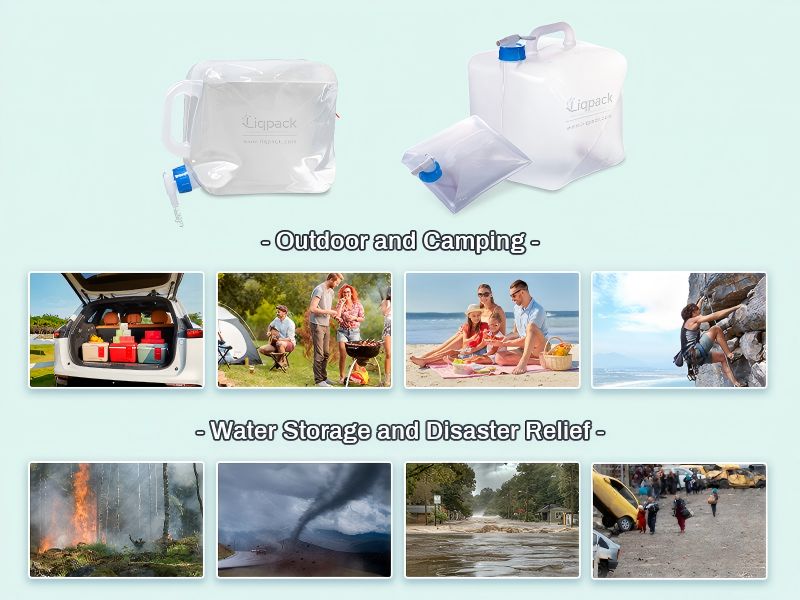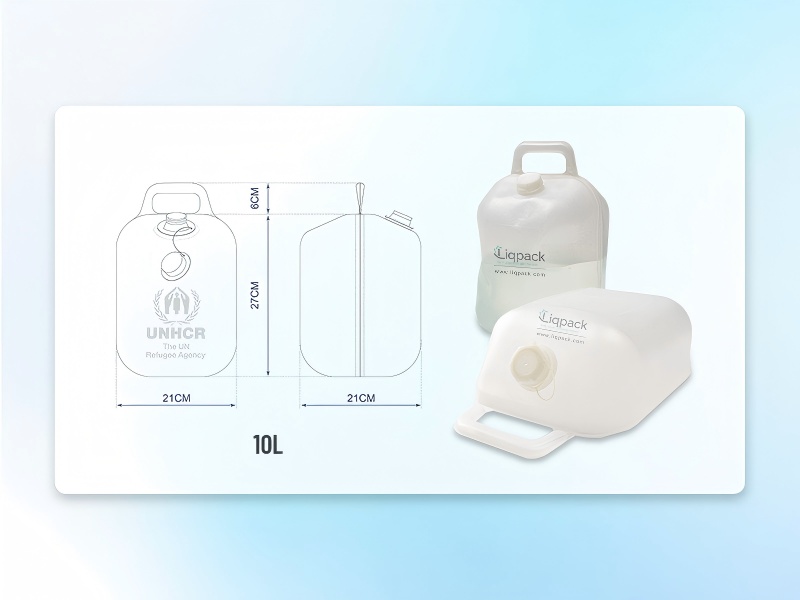
As costs and sustainability demands continue to grow, collapsible water containers offer a smart and space-saving solution for efficient liquid transport. We explore how they can reduce logistics costs and increase storage efficiency.
What Are Foldable Water Containers?
Foldable water containers are lightweight, reusable water storage units typically made from food-grade materials such as LDPE (low-density polyethylene) or TPU (thermoplastic polyurethane). These containers are engineered to hold water safely and collapse when empty, drastically reducing the volume they occupy.
They come in various sizes—ranging from 5L to 20L—and are widely used in camping, emergency relief, industrial fluid handling, and more. Many models include ergonomic handles, nozzles, or taps for easy use, and they meet international standards like UN and WHO requirements for liquid transport and hygiene.
Compared to rigid plastic or metal containers, foldable containers offer the same capacity while weighing less and occupying a fraction of the space when not in use.
Key Cost Drivers in Shipping and Warehousing
To understand the benefits of foldable containers, it’s essential to look at the key cost factors involved in shipping and warehousing:
- Shipping Volume: Freight charges are often based on dimensional weight (volume vs. actual weight). Bulky empty containers take up unnecessary space.
- Return Logistics: For operations involving returnable containers, shipping back rigid containers can be costly.
- Warehouse Space: Storing rigid containers, especially in large quantities, requires expansive storage facilities.
- Handling Labor: Moving and stacking traditional containers takes more time and effort, increasing labor costs.
Each of these logistics aspects adds to operational expenses, and addressing them with better container design is a smart move.

How Shipping Costs Are Reduced by Foldable Containers
The ability of foldable water containers to lower shipping costs is one of their biggest benefits. Here’s how:
Minimal Space When Empty
Unlike rigid jerry cans or drums, foldable containers can be flattened or rolled up when empty. This compressibility allows logistics companies to ship more units per container during backhauls or initial deliveries, reducing the number of shipments required.
Lightweight Design
Made from materials like LDPE or TPU, foldable containers are significantly lighter than plastic drums or metal jugs. Lower gross weight means lower shipping charges, particularly for air freight or long-distance logistics.
High Pallet Efficiency
Foldable water containers optimize pallet space. You can stack hundreds of collapsed containers on a single pallet, which translates to better utilization of transport vehicles and containers—cutting freight cost per unit.
How Foldable Containers Cut Warehousing Costs
Warehousing is another area where collapsible water containers shine. Their stackable and foldable nature helps organizations save space and reduce operating costs:
Flat Storage Capability
Foldable containers can be stored flat, taking up 80-90% less space than rigid ones. This is revolutionary for facilities that handle seasonal storage demands or have limited floor space.
Reduced Need for Racks or Bulk Storage Zones
Storing rigid containers typically requires racks, cages, or designated zones. Foldable containers simplify storage logistics and reduce the need for expensive infrastructure.
Improved Inventory Turnover
The ease of movement and accessibility of foldable containers make it quicker to pick, pack, and dispatch orders. Faster inventory turnover reduces warehousing time per unit, boosting efficiency.
Environmental and Operational Benefits
Cost savings aren’t just financial—they also translate into environmental and labor efficiencies.
Reduced Carbon Emissions
Fuel usage, pollution, and packaging waste are all decreased with fewer shipments and lighter loads. Organizations seeking to meet sustainability goals benefit from switching to foldable solutions.
Less Waste and Greater Reusability
Many foldable containers are designed for reuse. This extends their life cycle and reduces disposal costs associated with single-use plastics.
Reduced Labor Costs
Foldable containers are easier to carry, open, and store. This ease of use cuts down on labor time and the potential for injury from handling heavy, rigid containers.
Industry Use Cases and Real-World Savings
The cost-cutting advantages of foldable water containers aren’t just theoretical—they’re already making a difference across industries:
Emergency Response & Humanitarian Aid
NGOs and UN agencies deploy foldable containers for disaster relief and refugee camps due to their low weight, high durability, and ease of bulk storage and shipping. In many cases, these containers have helped reduce transport costs by up to 50% during emergency missions.
Retail & Wholesale Distribution
Companies selling water containers in bulk (online or in-store) benefit from the compact nature of foldable models, enabling more units to be stored in retail backrooms or e-commerce warehouses. Fewer restocks also mean reduced logistical overhead.
Industrial Fluid Supply
Industries needing mobile water supplies (e.g., construction, mining) use foldable containers to move and store fluids without tying up large areas of their worksite or spending more on logistics.

Choosing the Right Foldable Container for Cost Efficiency
To fully realize the cost savings, businesses must select the right container based on their use case. Consider the following:
- Size & Capacity: Larger containers offer better volume-to-weight ratios for shipping but may require more support for handling.
- Material Quality: Food-grade LDPE and BPA-free options ensure safety and durability, especially for water storage.
- Valve/Nozzle Type: Look for containers with integrated taps or spouts for easier use and less waste.
- Certifications: UN/WHO-approved containers are essential for institutional or international logistics.
By choosing certified, high-quality products, you avoid leakage, product loss, and repacking costs—all of which affect your bottom line.
Long-Term ROI: A Comparative Analysis
Let’s compare foldable containers vs. rigid jerry cans in terms of cost-effectiveness.
| Aspect | Foldable Water Container | Rigid Jerry Can |
| Empty Weight | 150–300g | 800–1500g |
| Return Volume | 10% of full size | 100% of full size |
| Pallet Efficiency | Up to 10x more per pallet | Low stacking |
| Initial Cost | Moderate | Moderate |
| Lifespan | Reusable (5–10 cycles) | Reusable (5–10 cycles) |
| Storage Space | Minimal when folded | Bulky |
| Shipping Cost | Low (light + compact) | High (heavy + bulky) |
Although both are reusable, the foldable container offers superior logistics value thanks to its compact form and weight advantage. Over time, especially in high-volume use, these differences compound into major savings.
Foldable water containers cut shipping and storage costs with their space-saving, lightweight design. Ideal for logistics, aid, or water distribution, they improve efficiency, safety, and sustainability. Choose certified models and streamline your supply chain today.
- Liqpack


